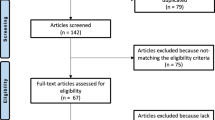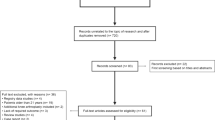Abstract
In patients with secondary osteoarthritis due to acetabular dysplasia, femoral anteversion has many variations. A changeable neck system is one useful option to adjust the femoral anteversion. Retroverted necks can effectively adjust anatomical anteversion (AA), femoral rotational angle (FRA), and functional anteversion (FA); however, effectiveness of anteverted necks for these adjustments has not been investigated. Moreover, although the lateral patellar tilt after total hip arthroplasty (THA) has been reported to externally rotate, the influence on lateral patellar tilt using a changeable neck system remains unknown. To clarify the effectiveness of anteverted necks in THA, 96 consecutive patients (111 hips) who underwent THA using anatomical short stem with a changeable neck system were retrospectively investigated using pre- and post-operative computed tomography. Patients were divided into the straight (ST) group using straight and 4-mm-high-offset neck (N = 34) and the anteverted (AV) group using 15°-anteverted and 15°-anteverted/3-mm-high-offset neck (N = 34) after age, body mass index, and surgical approach were matched using propensity scores. AA did not change in the ST group, while it increased by 14.0° in the AV group. FRA decreased after surgery in both groups. FA decreased after surgery in the ST group, while it did not change in the AV group. Lateral patella tilt did not significantly change in both groups between pre- and post-operative position. In conclusion, with a changeable neck system, straight and anteverted necks can adjust AA to achieve pre-operative planning while not influencing lateral patellar tilt.




Similar content being viewed by others
References
Ateschrang A, Weise K, Weller S, et al. Long-term results using the straight tapered femoral cementless hip stem in total hip arthroplasty: a minimum of twenty-year follow-up. J Arthroplasty. 2014;29:1559–65.
McLaughlin JR, Lee KR. Total hip arthroplasty with an uncemented tapered femoral component in patients younger than 50 years of age: a minimum 20-year follow-up study. J Arthroplasty. 2016;29:1275–8.
Carli AV, Poitras S, Clohisy JC, et al. Variation in use of postoperative precautions and equipment following total hip arthroplasty: a survey of the AAHKS and CAS membership. J Arthroplasty. 2018;33:3201–5.
Siguier T, Siguier M, Brumpt B. Mini-incision anterior approach does not increase dislocation rate. A study of 1037 total hip replacements. Clin Orthop Relat Res. 2004;426:164–73.
Bertin KC, Röttinger H. Anterolateral mini-incision hip replacement surgery: a modified Watson-Jones approach. Clin Orthop Relat Res. 2004;429:248–55.
Widmer KH, Zurfluh B. Compliant positioning of total hip components for optimal range of motion. J Orthop Res. 2004;22:815–21.
Sakai T, Sugano N, Nishii T, et al. Optimizing femoral anteversion and offset after total hip arthroplasty, using a modular femoral neck system: an experimental study. J Orthop Sci. 2000;5:489–94.
Sakai T, Sugano N, Ohzono K, Nishii T, Haraguchi K, et al. Femoral anteversion, femoral offset, and abductor lever arm after total hip arthroplasty using a modular femoral neck system. J Orthop Sci. 2002;7:62–7.
Sariali E, Mouttet A, Paquier G, et al. Accuracy of reconstruction of the hip using computerized three-dimensional preoperative planning and a cementless modular neck. J Bone Joint Surg Br. 2009;91-B:333–40.
Nakahara E, Uemura K, Ando W, et al. Effect of a modular neck hip prosthesis on anteversion and hip rotation in total hip arthroplasty for developmental dysplasia of the hip. J Artif Organs. 2020;23:255–61.
Wilson DA, Dunbar MJ, Amirault JD, et al. Early failure of a modular femoral neck total hip arthroplasty component: a case report. J Bone Joint Surg Am. 2010;92:1514–7.
Wright G, Sporer S, Urban R, et al. Fracture of a modular femoral neck after total hip arthroplasty: a case report. J Bone Joint Surg Am. 2010;92:1518–21.
Atwood SA, Patten EW, Bozic KJ, et al. Corrosion-induced fracture of a double-modular hip prosthesis: a case report. J Bone Joint Surg Am. 2010;92:1522–5.
Meftah M, Haleem AM, Burn MB, et al. Early corrosion-related failure of the Rejuvenate modular total hip replacement. J Bone Joint Surg Am. 2014;96:481–7.
Noble PC, Kamaric E, Sugano N, et al. Three-dimensional shape of the dysplastic femur: implication for THR. Clin Orthop Relat Res. 2003;417:27–40.
Akiyama K, Nakata K, Kitada M, et al. Changes in axial alignment of the ipsilateral hip and knee after total hip arthroplasty. Bone Joint J. 2016;98-B:349–58.
Sugano N, Noble PC, Kamaric E. A comparison of alternative methods of measuring femoral anteversion. J Comput Assist Tomogr. 1998;22:610–4.
Sugano N, Noble PC, Kamaric E, et al. The morphology of the femur in developmental dysplasia of the hip. J Bone Joint Surg Br. 1998;80:711–9.
Uemura K, Takao M, Hamada H, et al. Change in axial rotation of the femur in the resting supine position following total hip arthroplasty. Artif Organs. 2018;42:290–6.
Abe H, Sakai T, Takao M, et al. Difference in stem alignment between the direct anterior approach and the posterolateral approach in total hip arthroplasty. J Arthroplasty. 2015;30:1761–6.
Uemura K, Takao M, Sakai T, et al. The validity of using the posterior condylar line as a rotational reference for the femur. J Arthroplasty. 2016;31:302–6.
Semciw AI, Pizzari T, Murley GS, et al. Gluteus medius: an intramuscular EMG investigation of anterior, middle and posterior segments during gait. J Electromyogr Kinesiol. 2013;23:858–64.
Delp SL, Hess WE, Hungerford DS, et al. Variation of rotation moment arms with hip flexion. J Biomech. 1999;32(5):493–501.
Acknowledgements
This work was supported by JSPS KAKENHI Grant Number JP20K11254.
Author information
Authors and Affiliations
Corresponding author
Ethics declarations
Conflict of interest
The authors declare that they have no conflict of interest.
Additional information
Publisher's Note
Springer Nature remains neutral with regard to jurisdictional claims in published maps and institutional affiliations.
Rights and permissions
About this article
Cite this article
Yamazaki, K., Imagama, T., Matsuki, Y. et al. Evaluation of femoral anteversion, hip rotation, and lateral patellar tilt after total hip arthroplasty using a changeable neck system. J Artif Organs 24, 492–497 (2021). https://doi.org/10.1007/s10047-021-01269-1
Received:
Accepted:
Published:
Issue Date:
DOI: https://doi.org/10.1007/s10047-021-01269-1




